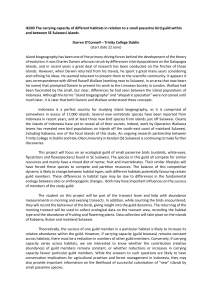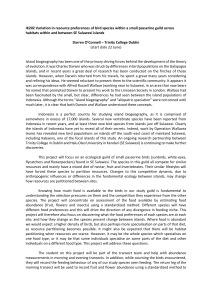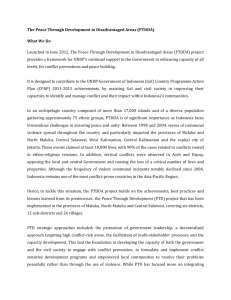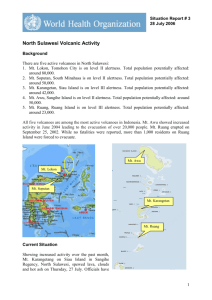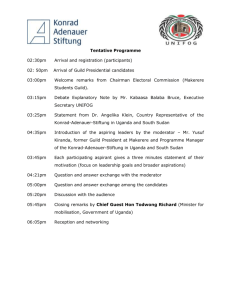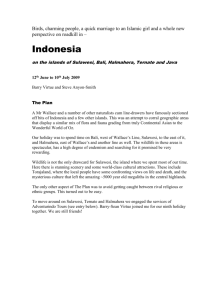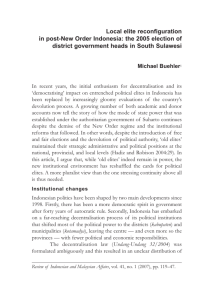Extended Project Summary
advertisement
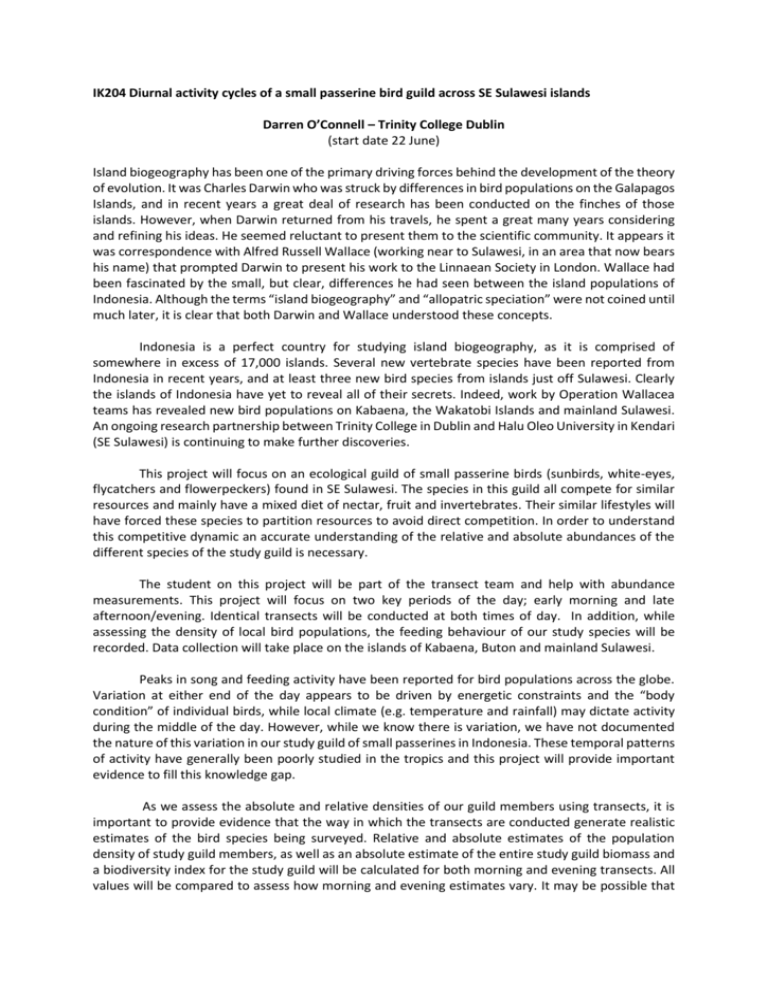
IK204 Diurnal activity cycles of a small passerine bird guild across SE Sulawesi islands Darren O’Connell – Trinity College Dublin (start date 22 June) Island biogeography has been one of the primary driving forces behind the development of the theory of evolution. It was Charles Darwin who was struck by differences in bird populations on the Galapagos Islands, and in recent years a great deal of research has been conducted on the finches of those islands. However, when Darwin returned from his travels, he spent a great many years considering and refining his ideas. He seemed reluctant to present them to the scientific community. It appears it was correspondence with Alfred Russell Wallace (working near to Sulawesi, in an area that now bears his name) that prompted Darwin to present his work to the Linnaean Society in London. Wallace had been fascinated by the small, but clear, differences he had seen between the island populations of Indonesia. Although the terms “island biogeography” and “allopatric speciation” were not coined until much later, it is clear that both Darwin and Wallace understood these concepts. Indonesia is a perfect country for studying island biogeography, as it is comprised of somewhere in excess of 17,000 islands. Several new vertebrate species have been reported from Indonesia in recent years, and at least three new bird species from islands just off Sulawesi. Clearly the islands of Indonesia have yet to reveal all of their secrets. Indeed, work by Operation Wallacea teams has revealed new bird populations on Kabaena, the Wakatobi Islands and mainland Sulawesi. An ongoing research partnership between Trinity College in Dublin and Halu Oleo University in Kendari (SE Sulawesi) is continuing to make further discoveries. This project will focus on an ecological guild of small passerine birds (sunbirds, white-eyes, flycatchers and flowerpeckers) found in SE Sulawesi. The species in this guild all compete for similar resources and mainly have a mixed diet of nectar, fruit and invertebrates. Their similar lifestyles will have forced these species to partition resources to avoid direct competition. In order to understand this competitive dynamic an accurate understanding of the relative and absolute abundances of the different species of the study guild is necessary. The student on this project will be part of the transect team and help with abundance measurements. This project will focus on two key periods of the day; early morning and late afternoon/evening. Identical transects will be conducted at both times of day. In addition, while assessing the density of local bird populations, the feeding behaviour of our study species will be recorded. Data collection will take place on the islands of Kabaena, Buton and mainland Sulawesi. Peaks in song and feeding activity have been reported for bird populations across the globe. Variation at either end of the day appears to be driven by energetic constraints and the “body condition” of individual birds, while local climate (e.g. temperature and rainfall) may dictate activity during the middle of the day. However, while we know there is variation, we have not documented the nature of this variation in our study guild of small passerines in Indonesia. These temporal patterns of activity have generally been poorly studied in the tropics and this project will provide important evidence to fill this knowledge gap. As we assess the absolute and relative densities of our guild members using transects, it is important to provide evidence that the way in which the transects are conducted generate realistic estimates of the bird species being surveyed. Relative and absolute estimates of the population density of study guild members, as well as an absolute estimate of the entire study guild biomass and a biodiversity index for the study guild will be calculated for both morning and evening transects. All values will be compared to assess how morning and evening estimates vary. It may be possible that different members of the study guild are “temporally partitioning”, being more active at different times of the day from each other so as to avoid direct competition for resources. It is hoped that this project will offer a validation of the current survey technique, while adding additional behavioural information for species within the study guild. Suggested reading It is recommended that you start with the text books (indicated with an asterisk) and work out from there. The reading list is split into several sections to provide an overview of the general areas that will be of use to you. Cycles of Activity John G. Blake (1992) Temporalvariation in point counts of birds in a lowland wet forest in Costa Rica. Condor 94: 265-275. John P. Kelly and Chris Wood (1996) Diurnal, intraseasonal, and intersexual variation in foraging behavior of the Common Yellowthroat. Condor 98: 491-500. R. T. Holmes, T. W. Sherry and S. E. Bennett (1978). Diurnal and individual variability in the foraging behavior of American Redstarts (Setophagaruticilla). Oecologia 36: 141-149. Sarah G. Taylor and Warren L. Paul (2006) Minimal diurnal change in foraging time in an Australian passerine, the White-Browed Babbler Pomatostomus superciliosus. Journal of Avian Biology 37: 527531. Peter Ward (Jan., 1969) seasonal and diurnal changes in the fat content of an equatorial bird. Physiological Zoology 42: 85-95. Robert J. Thomas et al. (2002) Eye size in birds and the timing of song at dawn. Proceedings of the Royal Society B: Biological Sciences 269: 831–837. DOI 10.1098/rspb.2001.1941 Predation Risks R. MacLeod, A. G. Gosler and W. Cresswell (2005) Diurnal mass gain strategies and perceived predation risk in the Great Tit Parus major. Journal of Animal Ecology 74: 956-964. Neil B. Metcalfe and Susan E. Ure (1995) Diurnal variation in flight performance and hence potential predation risk in small birds. Proceedings of the Royal Society B: Biological Sciences 261: 395-400. Jean-Marc Thiollay (1999) Frequency of Mixed Species Flocking in Tropical Forest Birds and Correlates of Predation Risk:An Intertropical Comparison. Journal of Avian Biology 30: 282-294. Bird Identification and Species Biology *Coates BJ, Bishop KD (1997) A guide to the birds of Wallacea. Alderly, QLD, Australia: Dove publications. *Cheke, R. A. and Mann, C. F. (2008a) Family Nectariniidae (Sunbirds). In del Hoyo, J., Elliott, A. and Christie, D.A. (Eds.), Handbook of birds of the world. Volume 13: Penduline-tits to Shrikes. Barcelona: Lynx Edicions. *Cheke, R. A. and Mann, C. F. (2008b) Family Dicaeidae (Flowerpeckers). In del Hoyo, J., Elliott, A. and Christie, D.A. (Eds.), Handbook of birds of the world. Volume 13: Penduline-tits to Shrikes. Barcelona: Lynx Edicions. *van Balen, S. (2008) Family Zosteropidae (White-eyes). In del Hoyo, J., Elliott, A. and Christie, D.A. (Eds.), Handbook of the birds of the world. Volume 13: Penduline-tits to Shrikes. Barcelona: Lynx Edicions. Sulawesi *Whitten T, Henderson GS, Mustafa M (2002) The ecology of Sulawesi. The ecology of Indonesia series, vol. 4. Hong Kong: Periplus Editions. Lee, T., Sodhi and Prawiradilaga, D (2007) The importance of protected areas for the forest and endemic avifauna of Sulawesi (Indonesia). Ecological Applications, 17; 1727-1741. Carel P. van Schaik and Michael Griffiths (1996) Activity periods of Indonesian rain forest mammals Biotropica 28: 105-112. Sangster G, King BF, Verbelen P, Trainor CR (2013) A New Owl Species of the Genus Otus (Aves: Strigidae) from Lombok, Indonesia. PLoS ONE 8(2): e53712. doi:10.1371/journal.pone.0053712 Harris JBC, Rasmussen PC, Yong DL, Prawiradilaga DM, Putra DD, Round PD, et al. (2014) A New Species of Muscicapa Flycatcher from Sulawesi, Indonesia. PLoS ONE 9(11): e112657. DOI:10.1371/journal.pone.011265 Kelly, S. B. A., Kelly, D. J., Cooper, N., Bahrun, A., Analuddin, K. and Marples, N. M. (2014) Molecular and phenotypic data support the recognition of the Wakatobi Flowerpecker (Dicaeum kuehni) from the unique and understudied Sulawesi Region. PLoS ONE, 9: e98694. doi: 10.1371/journal.pone.0098694. Rasmussen, P.C., Wardill, J.C., Lambert F.R. and Riley, J (2000) On the specific status of the Sangihe White-eye Zosterops nehrkorni, and the taxonomy of the Black-crowned White-eye Z. atrifrons complex. Forktail 16: 69-82. Indrawan, M., Rasmussen, P.C. and Sunarto (2008) A New White-Eye (Zosterops) from the Togian Islands, Sulawesi, Indonesia. The Wilson Journal of Ornithology 120: 1-9 Robinson-Dean, J. C., Willmott, K. R., Catterall, M. J., Kelly, D. J., Whittington, A., Phalan, B., Marples, N. M. and Boeadi, D. R. S. (2002) A new subspecies of Red-backed Thrush Zoothera erythronota kabaena subsp. nov.(Muscicapidae: Turdidae) from Kabaena island, Indonesia. Forktail: 1-10. http://orientalbirdclub.org/forktail18/
